Blog 03/30/2024 - MHT's Top 10 War Comic Books
MHT picks our Top 10 of Combat Comic Books!
Comic Book Historians generally divide the American comic book timeline into four eras; Golden, Silver, Bronze & Modern. The Golden Age of Comic Books began in 1938 with the creation of the superhero. The benchmark was the debut of Superman in Action Comics #1, published by Detective Comics (which evolved into the comic Colossus DC Comics), that is considered the modern comic book’s beginning’s that also included Batman, Wonder Women, Captain Marvel & Captain America.

With “Women’s History Month” wrapping up we will lead off with Wonder Women (WW) above-clockwise: The original WW with love interest Steve Trevor, U.S. Army; WW faces Nazi Red Panzer (a frequent critique is that WW faces far more bondage situations than any other superhero); quality WW propaganda; WW then in the blue, white star skirt & now as represented in film by Gal Gadot; WW on the battlefield.
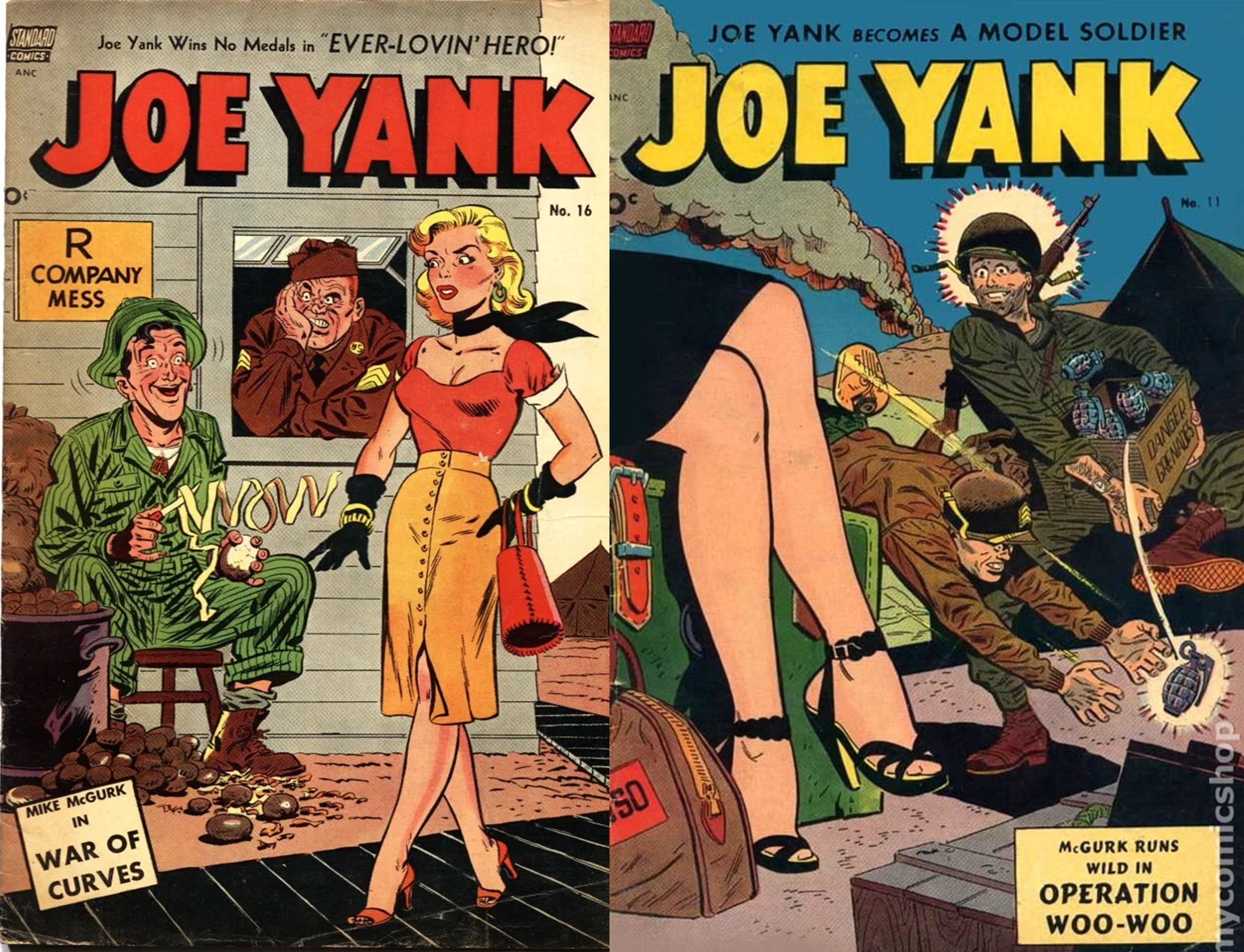
While the Golden Age did give us the true beginning of all the most famous superheroes, it also gave us a style of artwork unique to the time that has never been replicated. That style is known as Good Girl Art, abbreviated by fans today as GGA. GGA was the depiction of women in comic books, particularly characters who were bad to the bone, slick, tough but found herself in trouble dressed in very form fitting attire to present a hyper-sexualized version of femininity. The science fiction author Richard A. Lupoff defined good girl art as: “A cover illustration depicting an attractive young woman, usually in skimpy or form-fitting clothing, and designed for erotic stimulation. The term does not apply [i.e., refer] to the morality of the "good girl", who is often a gun moll, tough cookie or wicked temptress.”
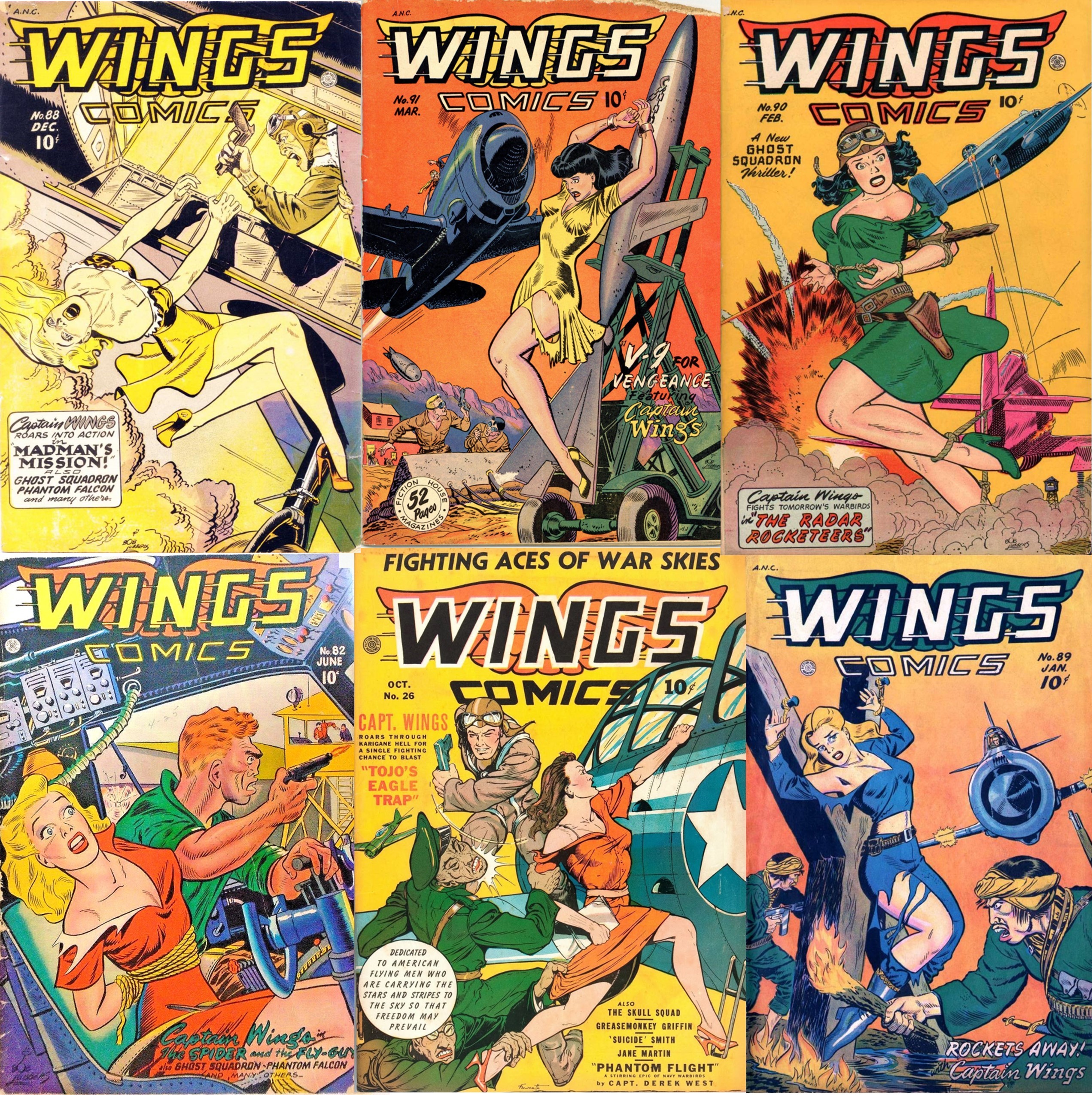
The style had peaked in popularity during the 1940’s when comics were extremely popular with WWII servicemen. It gave our real-life heroes overseas a tasteful way to “girl watch” as they fought the vital fight. The Fall of 1941 was a boom period for patriotic superheroes as the country prepared to enter WWII; during this period, comic book publishers launched Miss Victory, Miss America, the Star-Spangled Kid, U.S. Jones, Spirit of ’76, the Flag, Captain Flag & Yank & Doodle.
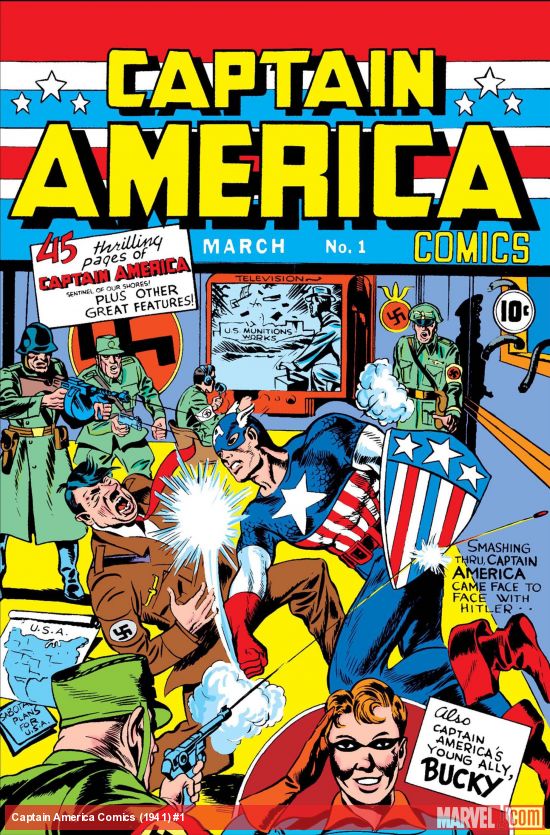
#10 - Captain America (#1 Published by Timely Comics (the predecessor to Atlas & later became the gold standard Marvel Comics) 01 March 1941.) Even prior to the U.S. involvement in WWII, after the attack on the U.S. Pacific Fleet at Pearl Harbor, Hawaii, what better way to introduce a hero clad in the American flag than by showing him decking Adolf Hitler? Simple & effective, the first-time readers were introduced to the “super-soldier serum” creating a superhero to fight the Nazis.
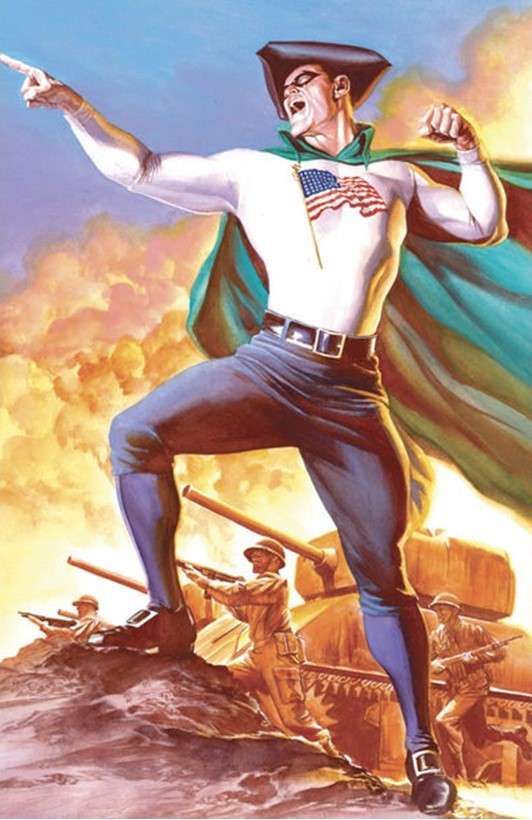
#9 - The Fighting Yank (#10 Published by Startling Comics September 1941.) Another WWII superhero who first appeared prior to the USA entering WWII. The Fighting Yank was Bruce Carter III, who obtained his superhuman powers when the ghost of his ancestor Bruce Carter I, a soldier from the American Revolutionary War, appears to him & shows him the location of a magical cloak that gives the wearer invulnerability & super strength as his forefather guides him against the evil Axis Powers during WWII.

Above (clockwise): The original Fighting Yank & an original GGA cover of Cave Girl. Cave Girl comic books were published from 1953 - 1954. Cave Girl's adventures are considered a great example of GGA. The bottom row has the new AC Comic version of Cave Girl (who in the future has lost nothing of her voluptuousness) & The Fighting Yank (2002) who have been hurtled into the future by a captured Soviet Time Machine & he is seen with three ladies from the Golden Age era Cave Girl, Mysta & Futura.
Golden Age War Comics were plentiful (note the number of titles & the titles similarities):
Publisher Quality Comics debuted its famous title Blackhawk in 1944 & it was published more or less continuously until the mid-1980s. Quality also began publishing G.I. Combat & Yanks in Battle during this era.
Industry giant DC Comics' produced war anthologies including such long-running titles as All-American Men of War; Our Army at War; Our Fighting Forces & Star-Spangled War Stories.
Another prolific publisher of war comics was Charlton Comics, which produced a wide variety of titles beginning in the 1950s, such as Battlefield Action; War at Sea; U.S. Air Force; Submarine Attack; Don Winslow: The Pride of the Navy; Foxhole; Fightin' Army; Fightin' Navy & Fightin' Marines.
Atlas had numerous titles such as War; War Action; Combat; War Adventures; Men's Adventures; Men in Action; Battle; Battle Fire; Marines in Battle; War Combat & Battle Front.
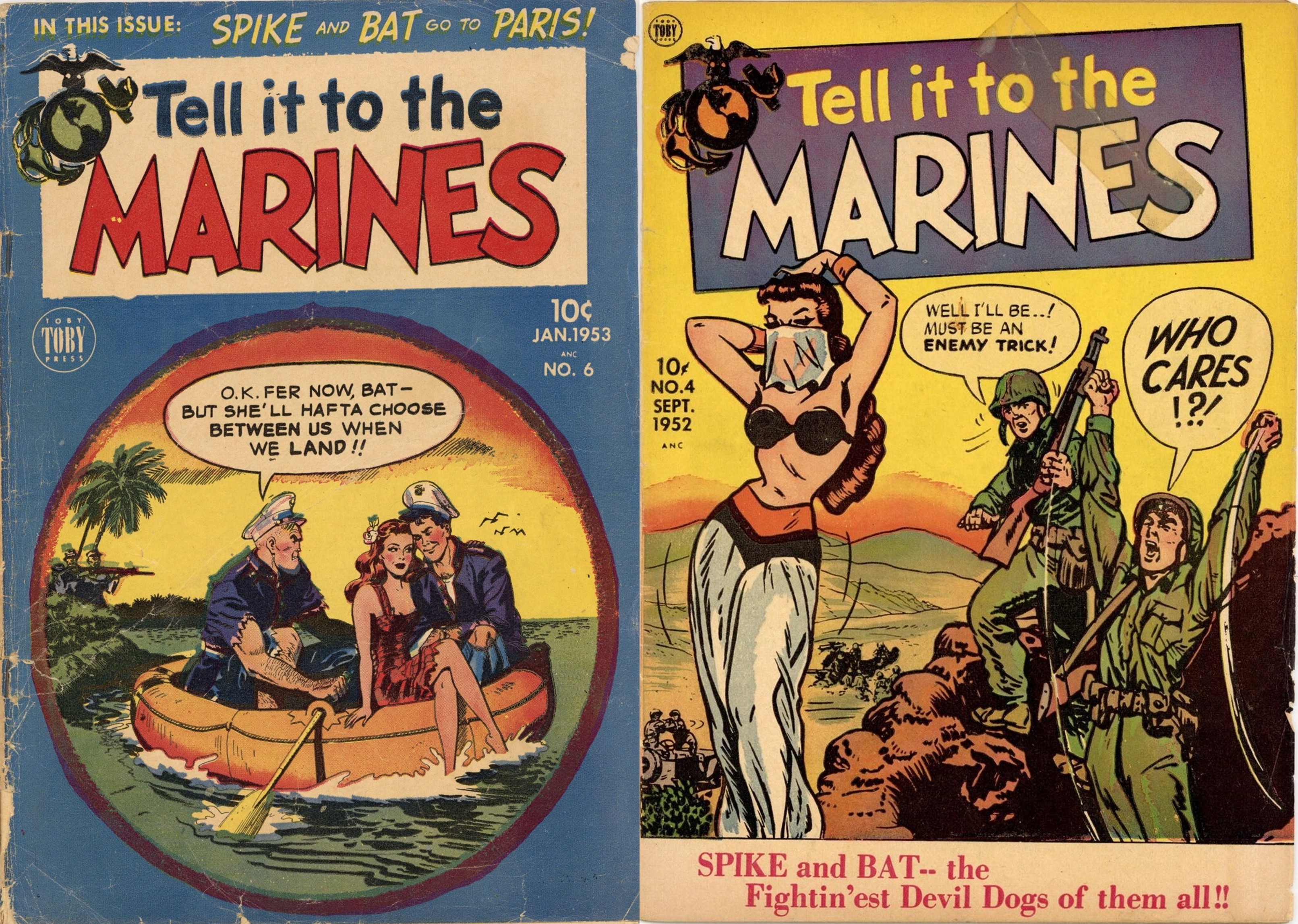
#8 - Tell it to the Marines (#4 & #6 Published by Toby Press 1952/53.) One of the most entertaining comics is Tell it to the Marines that featured two globe-trotting Leathernecks, the charismatic Bat & Spike who could fight with the best but enjoyed liberty just as much. Some of their classic stories: "Hypnotized Hero"; Spike is sent on a dangerous mission behind enemy lines after being hypnotized by Bat; "Week-End in Paris"; Spike & Bat encounter a cadre of communists in Paris; "Hawaiian Maneuvers"; The Shore Patrol is called in when Spike & Bat battle for the attentions of Lani; "Mam'selle Spells Trouble"; Spike & Bat strike-out with Fifi Delorm, a French news correspondent. Toby also published Monty Hall of the U.S. Marines & Tell It to the U.S. Marines on the Battlefields of the World!
Comic Media – War Fury / Star – Horrors of War / Harvey – True War Experiences; War Battles; War Battles - Shocking Tales of Combat / Farrell – The Fighting Man; War Stories / Avon - Buddies in the U.S. Army / AJAX - G.I. in Battle / Thrill – Warfront; Atomic War; War Comics; War Heroes / Standard Comics – Joe Yank, This is War; Exciting War! / Fiction House – War Birds; Wings (that ran from 1940 – 1954) / Entertaining Comics (EC) – Aces High was a 1955 title about WWI & WWII aviation. It lasted a total of five issues before being cancelled. / Frontline Combat / Two-Fisted Tales.
Fawcett Comics had several successful comic books during the 1940s Golden Age. Its most popular character was Captain Marvel; plus, Soldier Comics; Battle Stories; Bill Battle, The One-Man Army & Captain Midnight.
In the early 1950s, more violent Korean War stories appeared using the same unflattering Asian stereotypes used to make the Japanese more menacing in WWII comics. In contrast to the typical glamorizing approach of most war titles, EC Comics editor Harvey Kurtzman with titles Frontline Combat & Two-Fisted Tales depicted combat realistically & in unforgiving detail, exposing what he saw as the truth about the horrors of war without idealizing it.
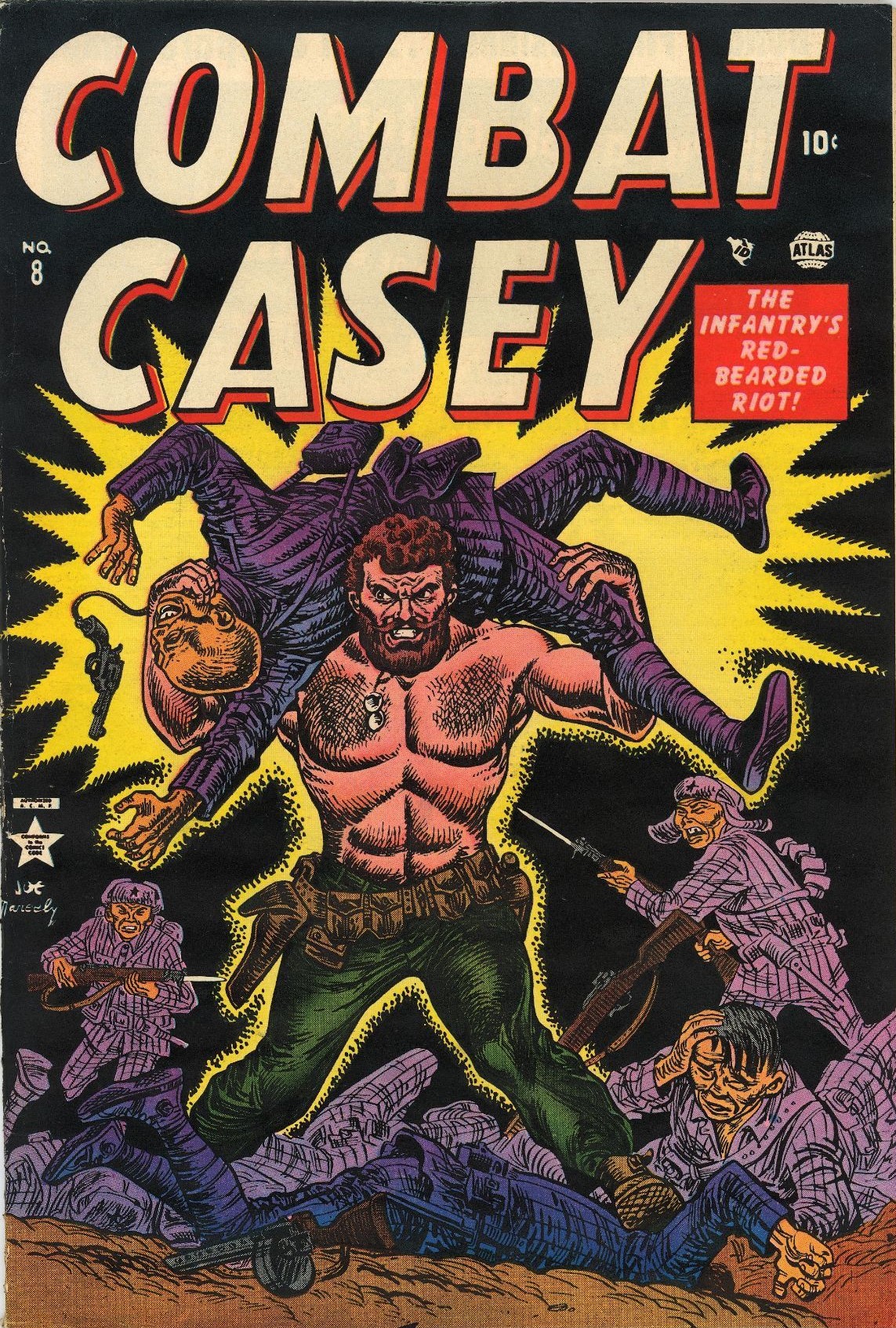
Many of the comic protagonists were highly unbelievable, but at the top of the list was Combat Casey that was published by Atlas (that would become the powerhouse Marvel) Publication Dates: January 1953 - July 1957 so it focused on the Korean War with the subtitle “The Infantry’s Red Bearded Riot!” Casey who sported a luxurious full red beard & often loses his shirt when fighting the North Korean & Communist Chinese Army soldiers.
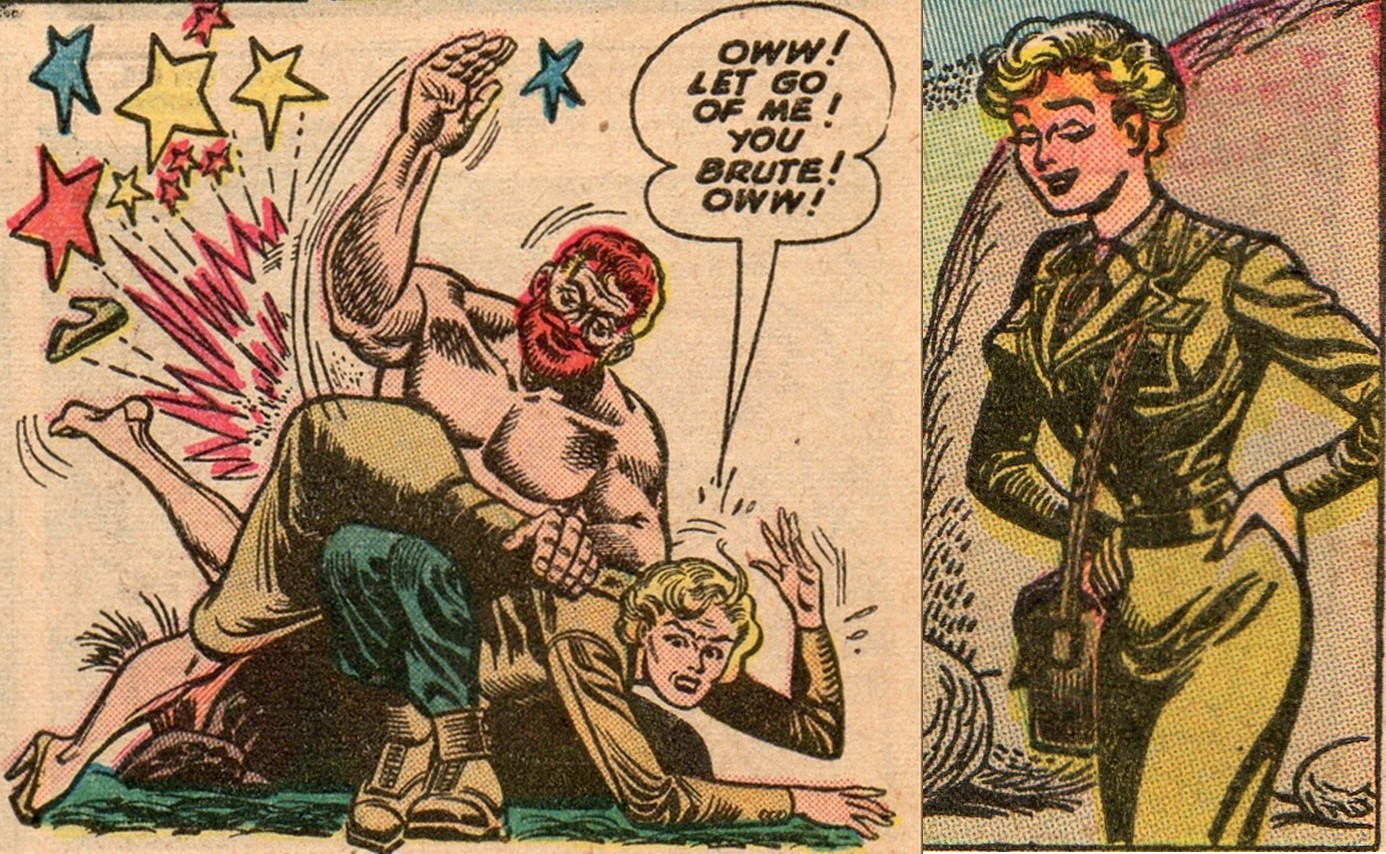
In the above story line that couldn’t be printed today, Army Sargeant Combat Casey again shirtless takes Combat Correspondent Torchy Finnegan, who makes even the awful army uniform look good, on patrol. She takes a verbal shot at Combat’s beard & he raises his M-1 & fires multiple shots at Torchy. She flies into a fury at being scared of being murdered until she sees the body count of enemy soldiers behind her, uttering the great line “Shivering Shamrocks! Dead Reds…!” Combat then puts her across his knee & gives her an old-fashioned spanking. Luckily this red-headed leader isn’t running for public office so Torchy won’t be testifying in a New York courtroom!

The Golden Age ended in 1955, when noted German-born psychiatrist Fredric Wertham wrote a scathing condemnation of the comic book medium in his book “Seduction of the Innocent” (1954.) He argued that comic books were responsible for a surge in juvenile delinquency & reading them posed a potential impact to a child's sexuality & moral values. Out of all the artists who practiced GGA at the time, one of the most well-known was Matt Baker. Baker, who unfortunately passed away at the age of 37 in 1959 was one of the few African Americans working in the comic book industry at that time. His work on Phantom Lady & Fiction House Jumbo Comics are some of the Golden Ages most iconic covers. Wertham’s critique of comic covers like Baker's cover for Phantom Lady #17 (April 1948) (pictured above) was reproduced in his book to highlight the trend of bondage & danger to scantily clad women to bolster his claim that comic books were inappropriate for impressionable minors.

This led to his testifying for the American Senate Subcommittee on Juvenile Delinquency, which launched an investigation into comic books. In the ensuing furor from the government & media, the U.S. comic book industry set up the Comics Magazine Association of America (CMAA.) The CMAA instilled the Comics Code Authority (CCA) in 1954 & drafted the self-censorship Comics Code that year, with 19 requirements that had to be met for approval. Publishers who relied on GGA combined with bondage covers for their sales (such as "Cave Girl" publisher Fiction House) quickly went out of business due to restrictions enforced by the CCA. Bondage covers became far less frequent & those that were approved usually illustrated the restrained female in a less risky manner than what was previously the rule. The surviving publishers now included male characters (usually teammates) in the same bondage situation as the female characters in order to dilute the perception that the cover was being sexually exploitative. Despite the CCA's censorship, some Golden Age style bondage covers still managed to make it to print. It did lead to the disappearance of many crime titles & Phantom Lady’s cleavage & short shorts. It was almost two decades before two new Phantom Ladies (see below) were resurrected with even less costuming when the CCA lapsed in the 2000s.
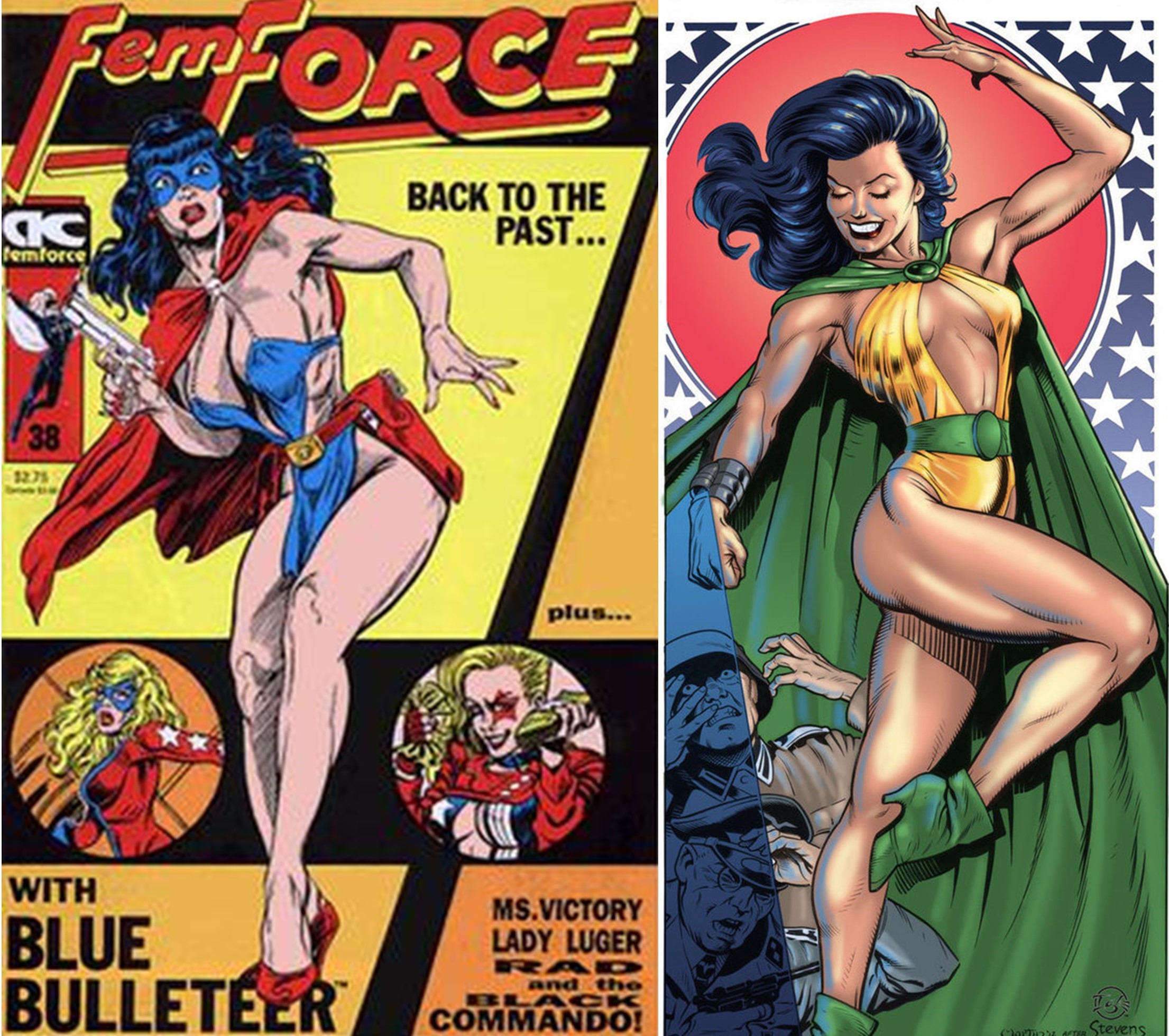
Silver Age War Comics
The CCA ushered in the Silver Era as the pre-code Golden Era ended. The Silver Era is generally considered to date from the first successful revival of the then-dormant superhero form, with the debut of the modern Flash in the Showcase #4 (Oct. 1956) issue. It lasted through the late 1960s or early 1970s, as Marvel Comics revolutionized the medium with more lifelike superheroes led by iconic writer, editor, publisher, & producer Stan Lee adding Jack Kirby's Fantastic Four & Steve Ditko's Spider-Man who all experienced real-life problems. In 1959, several recurring characters began to appear in mainstream comic anthologies, including Sgt. Rock & The Haunted Tank in the DC lineup. These recurring characters began as regular "guests" in Our Army at War and later graduated to their own comic books.

#5 - Haunted Tank (#99 Published by DC Comics May 1963.)
A "High-concept," is a term Hollywood uses for an innovative idea, that is rare in war comic books where most of the protagonists are ordinary fighting men. A notable exception is DC Comics' long-running series, The Haunted Tank. The idea behind The Haunted Tank was to have the ghost of a warrior out of history return to act as protector & advisor to a latter-day namesake. Of course, no idea is completely new, & we have already covered the Golden Era superhero The Fighting Yank. However, when first-rate writer/editor Robert Kanigher & artist Russ Heath introduced Sgt. Jeb Stuart, USA & his supernatural forebearer, General J.E.B. Stuart, in G.I. Combat #87 (April-May, 1961), it was a unique storyline.

The Confederate general had been sent by the spirit of Alexander the Great to guard over his living descendant, who commanded a M3 Stuart light/Jigsaw composite/M4 Sherman medium tanks in North Africa & Europe during WWII. J.E.B. didn't enjoy the assignment at first, but warmed to the task when Jeb honored him by fighting under the battle flag of the Confederacy. That surely wouldn’t be allowed in today’s cancel culture. Jeb was the only one who could see & hear J.E.B. & never hid the connection as his crew thought him crazy. The Haunted Tank was a hit with readers & was the cover feature in G.I. Combat second only to Sgt. Rock as DC's longest-running war series.
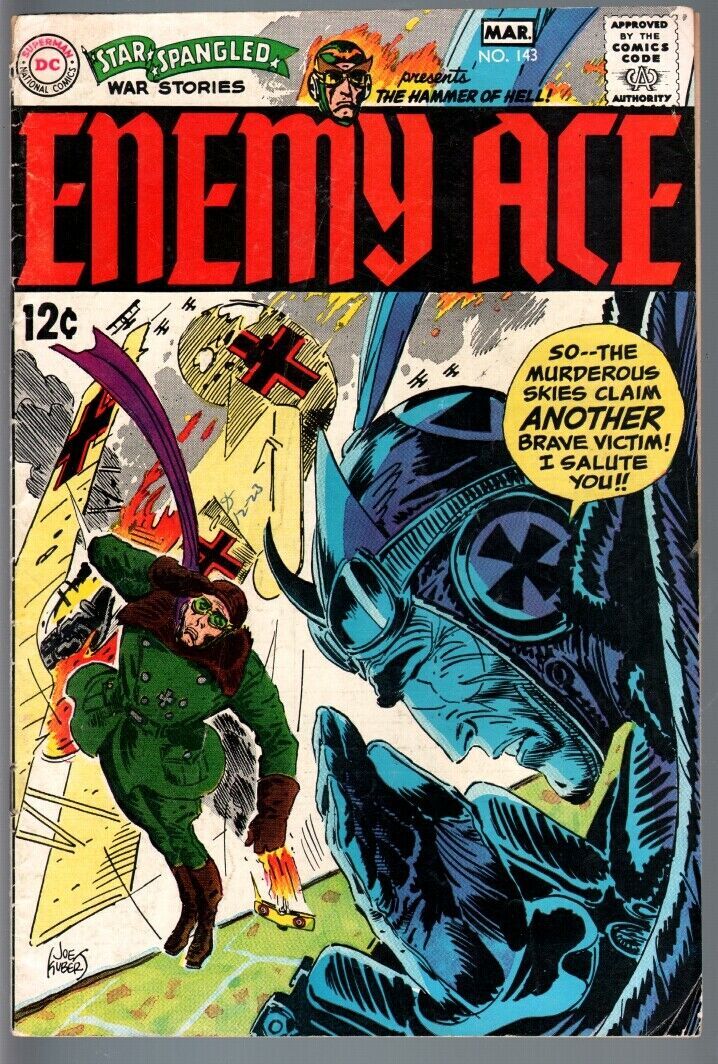
#4 - Enemy Ace (#143 Published in Star Spangled War Stories by DC Comics Mar 1969.)
WWI’s Enemy Ace was created by DC’s ace writer Robert Kanigher & the unmatched comic book artist Joe Kubert, first appearing in Our Army at War #151 (1965.) Rittmeister Hans Von Hammer, the Enemy Ace, was loosely based on the real-life Red Baron, Manfred von Richthofen. Both flew Blood Red Fokker DR1 triplanes. Both were of aristocratic Prussian blood. Both awarded themselves a trophy with each downed enemy plane. Both were the highest scoring flying ace of the First World War. The main difference between the two was that Von Hammer survived to old age, whereas Von Richthofen was shot down & killed before the war ended.
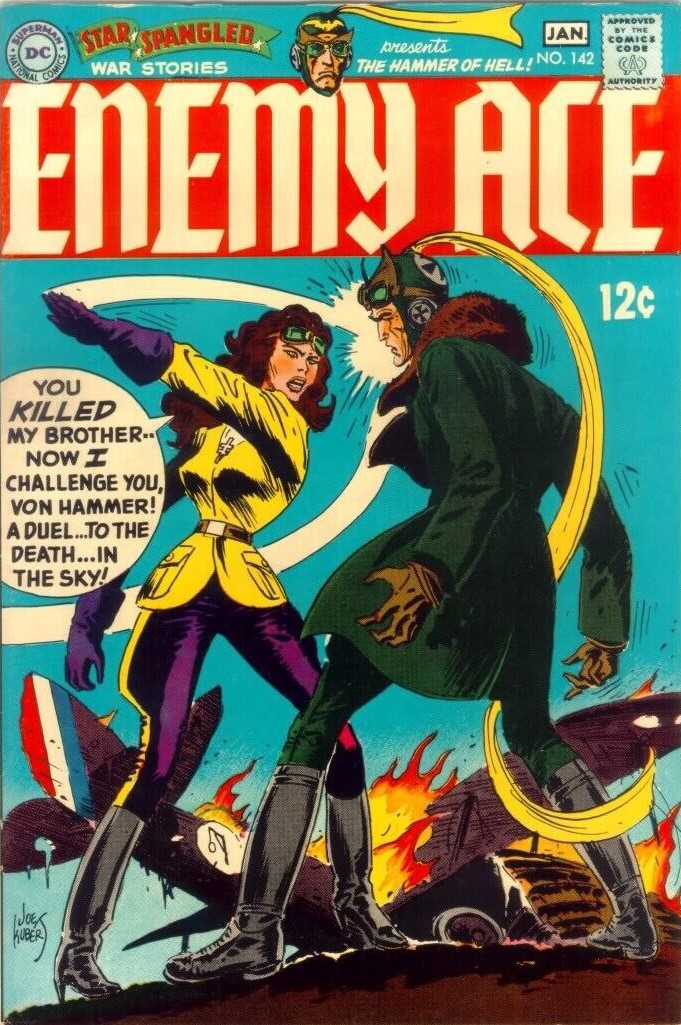
The nickname “Hammer of Hell” by both friends & enemies make him the perfect killing machine as his only friend is a Black Forrest wolf. He duels with the French ace “The Hangman” knocking him from the sky only to have his sister rise up as a flyer to seek revenge for her brother.
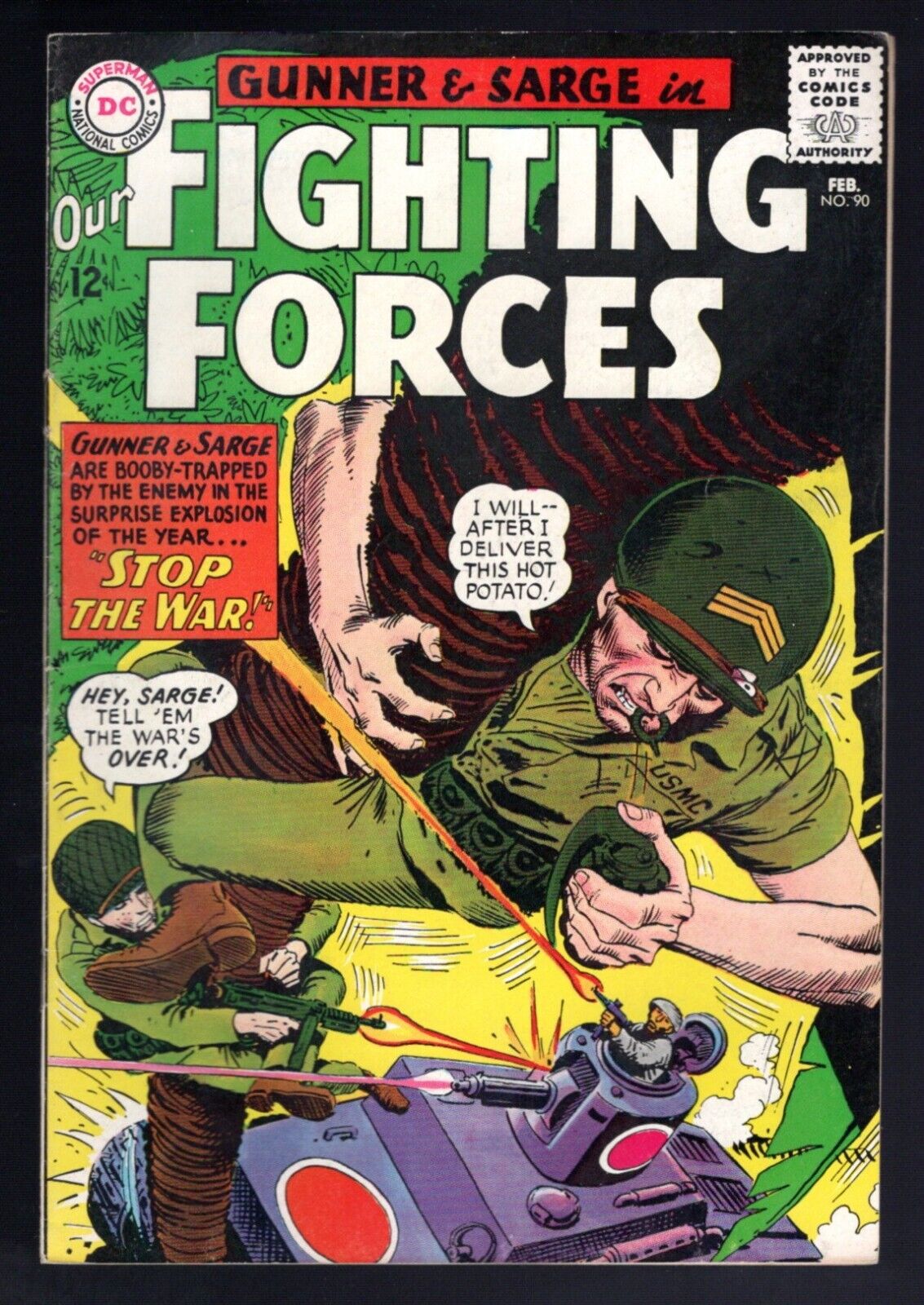
#3 - Gunner & Sarge (#90 Published in Our Fighting Forces by DC Comics Mar 1965.)
Gunner & Sarge was yet another classic written by Robert Kanigher with artist Ross Andru in March 1959. It introduced a pair of Marines, a sergeant & a private, working together somewhere on an island in the Pacific. Their names were never given, possibility to emphasize the "everyman" aspect of our Greatest Generation’s selflessness in fighting WWII.

Four issues later, they picked up a K-9 German Shepherd, who was addressed only by his function in the team, Pooch. After that, the series was sometimes referred to as Gunner, Sarge & Pooch. Unlike all the single comic book stars they had that buddy film vibe like Butch Cassidy & the Sundance Kid, Running Scared, Lethal Weapon & 48 Hrs. After defeating an endless stream of Imperial Japanese Army soldiers, strafing Japanese Zero fighters & even Japanese Imperial Navy torpedoes! DC tried to replace them with the Fighting Devil Dog, (Sgt Rock’s younger brother) & that would have been their end but luckily, they were swept up into “The Losers” team created for the purpose of assembling popular stars who had lost their series.
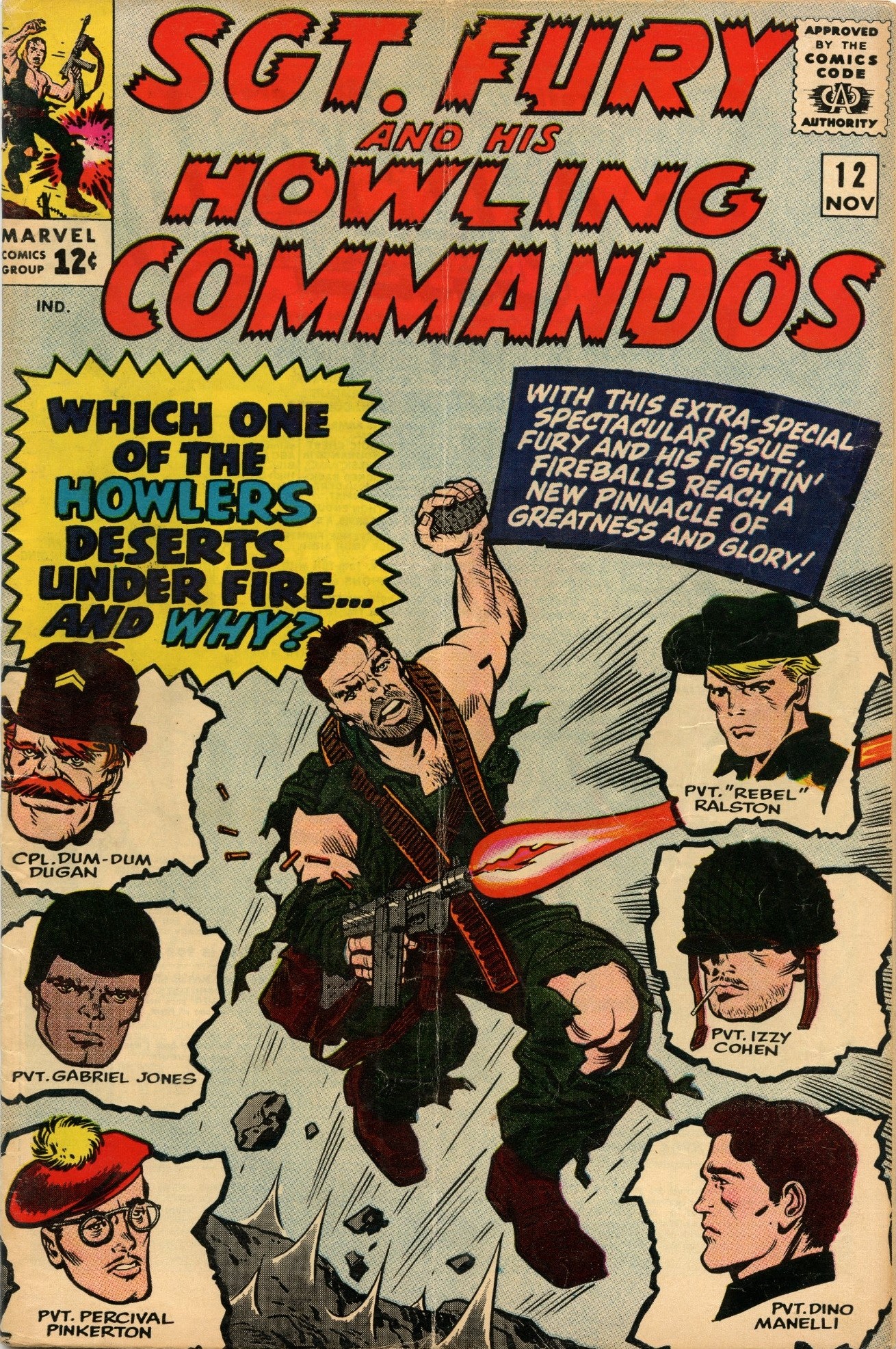
#2 - Sgt. Fury and his Howling Commandos (#12 Published by Marvel Nov 1964.)
Sgt. Fury and his Howling Commandos is a comic book series created by Marvel’s A-Team of Jack Kirby & Stan Lee (their first & only collaboration on a war comic) that ran from 1963 to 1981. The main character, Sgt. Nick Fury, later became the Director of Marvel's super-spy agency, S.H.I.E.L.D. The title also featured the Howling Commandos, a fictional WWII special operation unit that does lots of bullet dodging, grenade lobbing, one-armed machine gunning & is done in the Lee/Kirby style, with lots more light-hearted banter plus a diverse mix of appealing characters. The U.S. Army Rangers Howlers were Corporal "Dum Dum" Dugan (a hot-tempered, red-headed Boston Irishman in a bowler hat), Izzy Cohen (possibly the first Jewish action hero), "Rebel" Ralston (an easygoing Kentuckian & former jockey), Percival "Pinky" Pinkerton (a bumbershoot-wielding Englishman, think David Niven who replaced the KIA "Junior" Juniper Ivy League dropout in a daring move for comics at the time), Dino Manelli (an Italian actor like Dean Martin fluent in Italian & German), Gabe Jones (a black man when the U.S. Army hadn’t segregated), & of course, gruff, all-American Nick Fury himself.
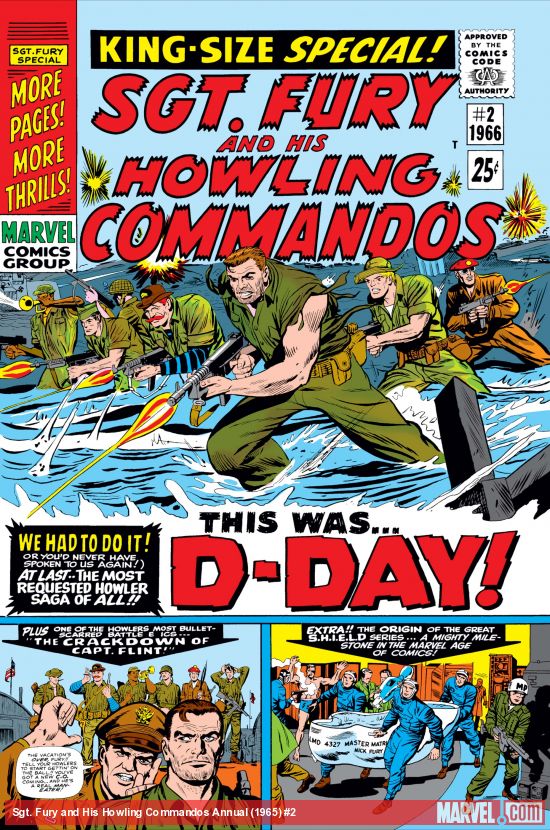
Lee & Kirby stayed with Sgt. Fury & His Howling Commandos for a little over a year but it remained Marvel’s most successful war comic the company ever published, lasting until 1981. It took a few years, but the derivative Captain Savage, USN & His Leatherneck Raiders eventually followed. The group was retitled Captain Savage & His Battlefield Raiders probably due to readers not being familiar with military slang, in which a Leatherneck is a member of the U.S. Marines. Another Marvel copycat comic was the short-lived Combat Kelly and the Deadly Dozen which like the “Dirty Dozen” was a unit of criminals unleashed on the enemy.
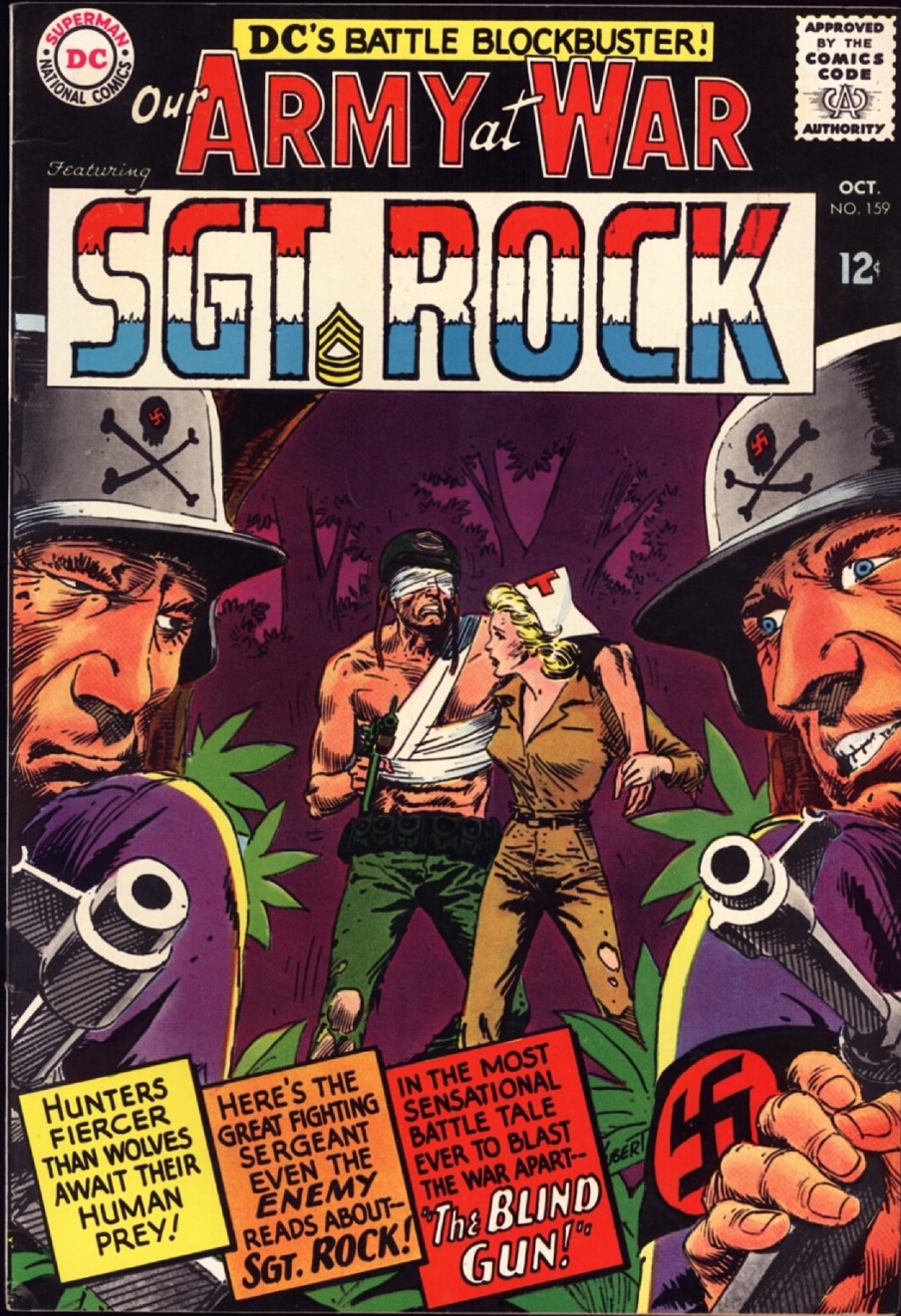
#1 SGT Rock - (#159 Published in Our Army at War by DC Oct 1965.)
Sgt. Rock was created by the comic book masterminds Robert Kanigher (author) & Joe Kubert (artist), first appearing in Our Army at War #81 (1959.) It starred Master Sergeant Frank Rock - The "topkick" or senior Non-Commissioned Officer of "Easy Company." Rock was a steelworker from Pennsylvania who enlisted in the U.S. Army the day after the attack on Pearl Harbor. The classic Rock was usually dressed in olive drab fatigues that usually ended in tatters, armed with a .45-caliber M1A1 Thompson submachine gun (sometimes a M50 Reising) & a .45-caliber Colt M1911A1 semi-automatic pistol. He is almost always depicted with an M1 Garand cartridge belt which stored ammunition useless to him, as well as two belts of .50-caliber ammunition belts which Rock considers lucky charms & a personal trademark. Rock is always shown with a number of hand grenades secured to his equipment that he is able to throw with amazing accuracy. He is a highly effective close combat fighter, mostly using an MMA style of street fighting mixed with boxing & judo.
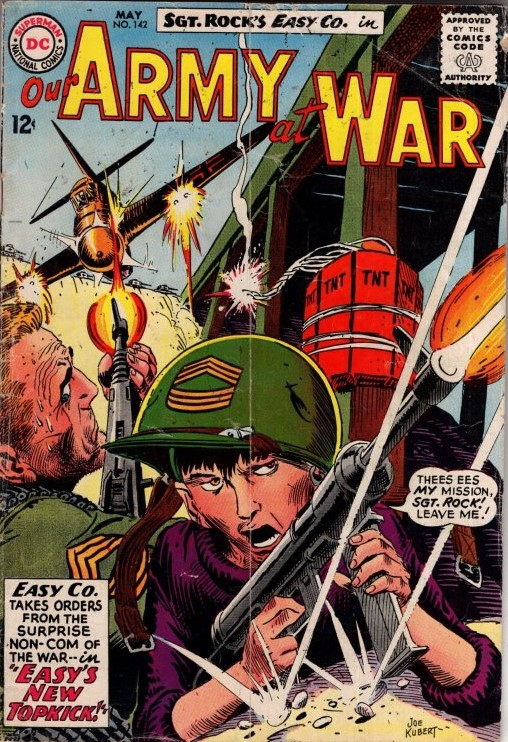
Rock was a crack shot, able to shoot down several German aircraft with his submachine gun a quick survey revealed the count being three Messerschmitt Bf 109s & one Focke-Wulf Fw 190 fighters, a Junkers Ju 87 Stuka dive bomber & even a Heinkel He 111 bomber. He seems to have close to superhuman endurance & strength, surviving exposure to freezing water, a large number of gunshot wounds & fragments from hand grenades, tank rounds, bombs & artillery. Rock's uses his "Combat Antenna" a sixth sense to warn Easy Company of impending enemy attack. With very few exceptions, Rock maintains complete calm & determination under fire, even when the odds are stacked against Easy's success or survival.

His “Combat-Happy Joes” of Easy Company include his number two Corporal Bulldozer a hulking figure; Wildman with his bright red full beard; Little Sure Shot an Apache sniper who always decorates his helmet with feathers; Ice Cream Soldier a soldier who is always cool in combat; Zack Easy's original bazooka man, lost one arm in combat; Wee Willie a small sized soldier; Sunny who was always smiling; Junior who lied about his age to enlist; Nick with the walkie-talkie & Archie an older soldier.

The original Mademoiselle Marie (often shortened to Mlle. Marie) was introduced in Star Spangled War Stories #84, created by Robert Kanigher & Jerry Grandenetti. Marie was a French farm girl who joined the French Resistance during WWII. The red beret-wearing character is notable as being the only love interest of Sgt. Rock. She was based in part on several actual members of the French resistance, most notably Simone Segouin who was famously captured on film by LIFE Magazine’s Robert Capa rocking the German MG42 submachine gun during a mopping up action after Paris was liberated in 1944.
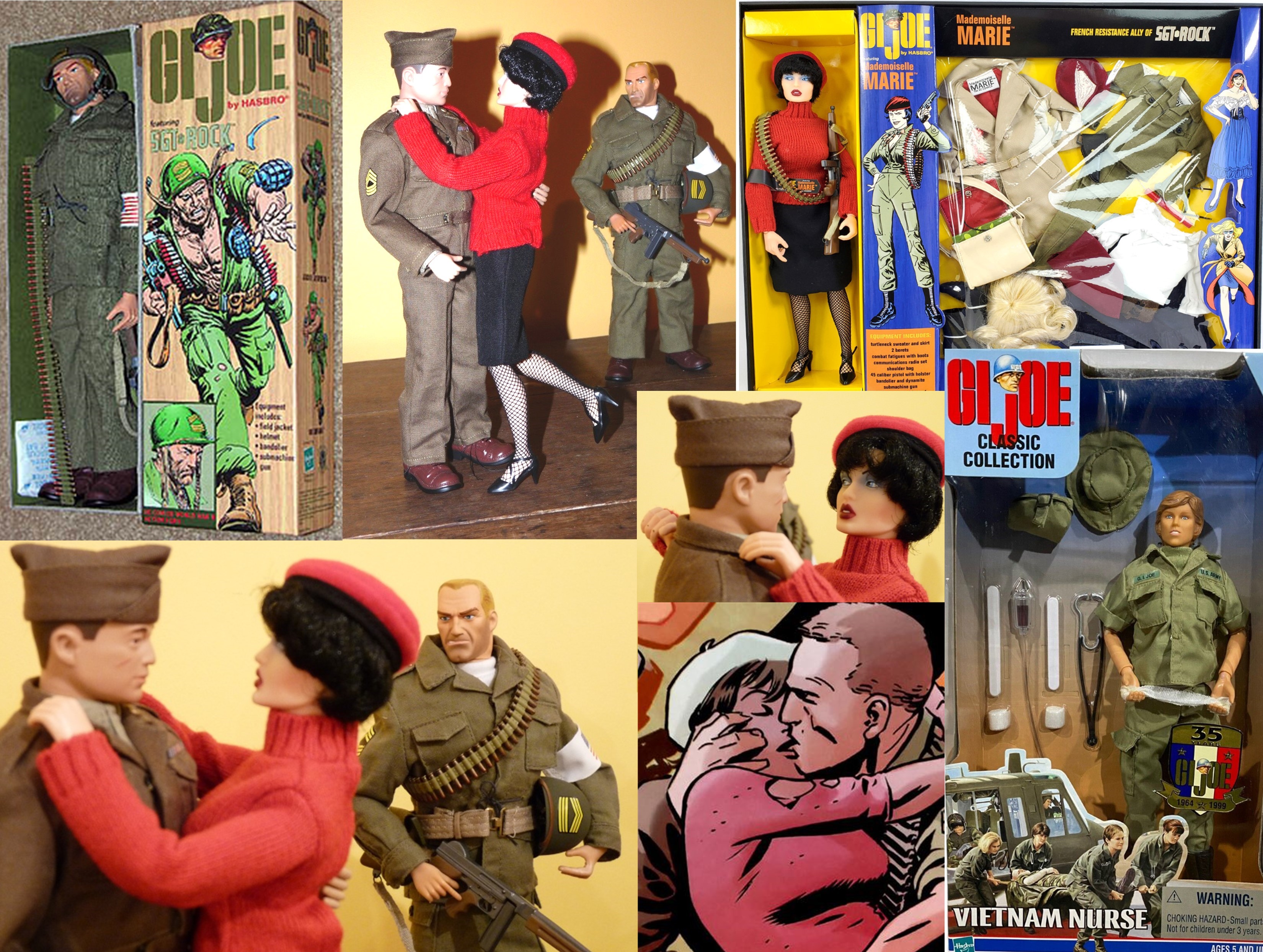
In 2002, a limited-edition Sgt. Rock action figure was released by Hasbro Toys, as part of the 12" G.I. Joe original sized action figure line, including four other characters from the comic book series; three more originals Bulldozer, Little Sure Shot, Wildman & Jackie Johnson (a later added African-American boxer despite the historical inaccuracy.) The figures wore World War II-era fatigues and mostly carried the same weapons as in the comic books (though the Bulldozer figure carries an M-1 rifle instead of his usual air-cooled Browning .30-calibre machine gun.) A female figure was also released, portraying French Resistance fighter Mademoiselle Marie, Sgt. Rock's love interest during the comic book series. In the diorama photo, the Sgt Rock figure is none too happy having his only girlfriend hanging on another Master Sergeant, this one an original GI Joe in a service dress uniform.
End of the Silver Age
By the late 1980s, a great number of venerable war titles (mostly anthologies or WWII themed titles) from the late 1950s and 1960s "Silver Age of Comic Books" died out. War comics series that ended long runs in the 1980s, following publication of over 100 issues, include:
Blackhawk (Quality/DC, 273 issues from 1944 to 1984)
Fightin' Army (Charlton, 157 issues from 1956 to 1984)
Fightin' Marines (Charlton, 163 issues from 1955 to 1984)
G.I. Combat (Quality/DC, 288 issues from 1952 to 1987)
Our Fighting Forces (DC, 181 issues from 1954 to 1978)
Sgt. Fury and his Howling Commandos (Marvel, 167 issues from 1963 to 1981)
Sgt. Rock/ Our Army at War (DC – combined run was 422 issues from 1952 to 1988)
Star Spangled War Stories/The Unknown Soldier (DC – combined run was 268 issues from 1952 to 1982)
Weird War Tales (DC, 124 issues from 1971 to 1983)
New titles were still appearing, one being Marvel's The 'Nam, which debuted in 1987 to 1993 & was based during the first year on writer Doug Murray's actual Vietnam experiences. He was surprised that Marvel green lighted his Vietnam-war themed comic: "I never expected anything to come of it because war books were already pretty much dead at that point in 1985." Another focused on Vietnam was Don Lomax's Vietnam Journal, published by Apple Comics had a 16 issue run from 1987 to 1991.
Bronze Age War Comics
The Bronze Age of American superhero comic books ran from 1970 to 1985. The biggest indicator was in 1970, when Jack Kirby left Marvel Comics, ending the most important creative partnership of the Silver Age (with Stan Lee) when he moved to DC.
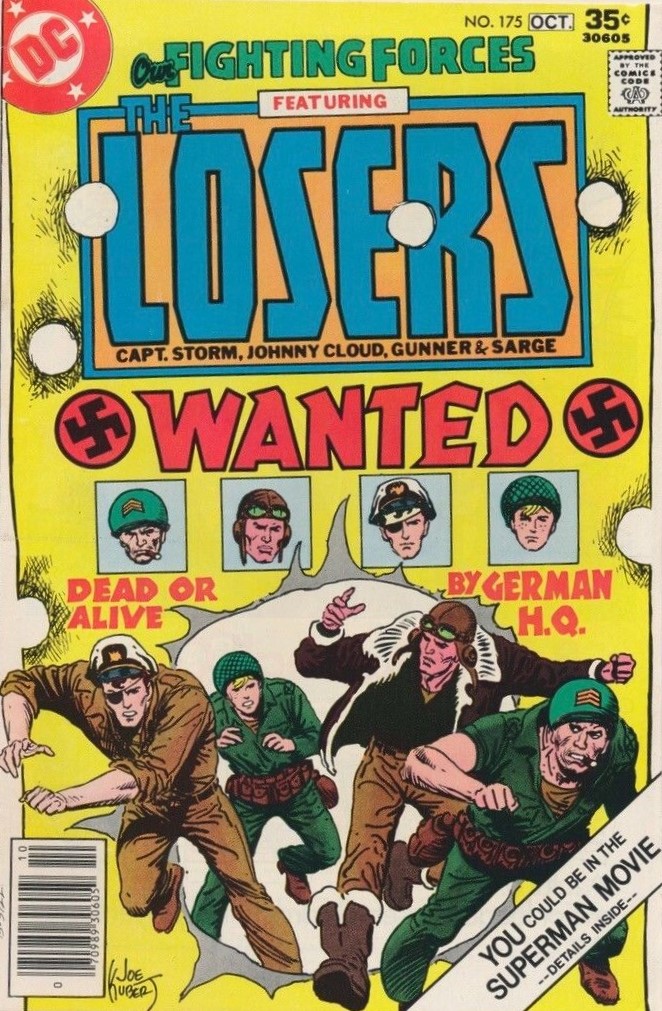
#6 - The Losers (#175 Published by DC Comics 1977.)
The first issue of The Losers became a regular feature in DC's long-running war comic book series Our Fighting Forces beginning with issue #123, dated January/February 1970. Prior to the formation of this special operation unit, each character had their own adventures in DC's war anthology comics. The members included:

Captain Johnny Cloud, USAAF. Cloud was a Navajo P-51 Mustang fighter pilot who suffered from prejudice when he was introduced as a lieutenant in the WWII U.S. Army Air Force, in DC's All-American Men of War #82 (December, 1960.) He earned the respect of the squadron with a spectacular aerial maneuver & replaced the fatally wounded commander renaming the squadron "The Happy Braves." If his skin color or the new name of the outfit weren't enough to keep the reader aware of his ethnic heritage, he also had a recurring vision. Cloud formations resembling a Navajo warrior on a horse repeatedly inspired him to greater effort.
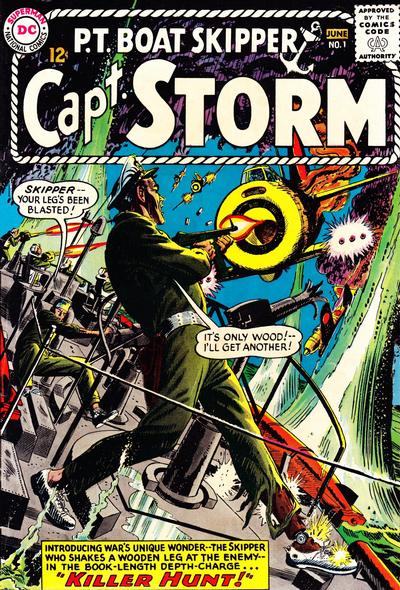
Lieutenant William Storm, USN. President Kennedy who had famously commanded PT-109 had only been dead several months when DC Comics launched their own PT-Boat commander with a nod to Moby Dick. The captain Ahab figure was Storm, who, on his very first cruise loses his boat, his crew & one leg. He swore vengeance on the grinning Japanese Submarine Captain who machine gunned his crew became Storm’s White Whale. A nurse pulls him out of a near-suicidal funk while he was convalescing with his new wooden leg. His saving of a medical officer's daughter from drowning gets him back on active duty & a new boat. The sailors are skeptical but Storm leads them to victory with bravery being shot in his wooden leg earns him the title "Skipper."
Gunner & Sarge. We have seen them as #3. Gunner's K-9 Pooch also joins the team for some missions.
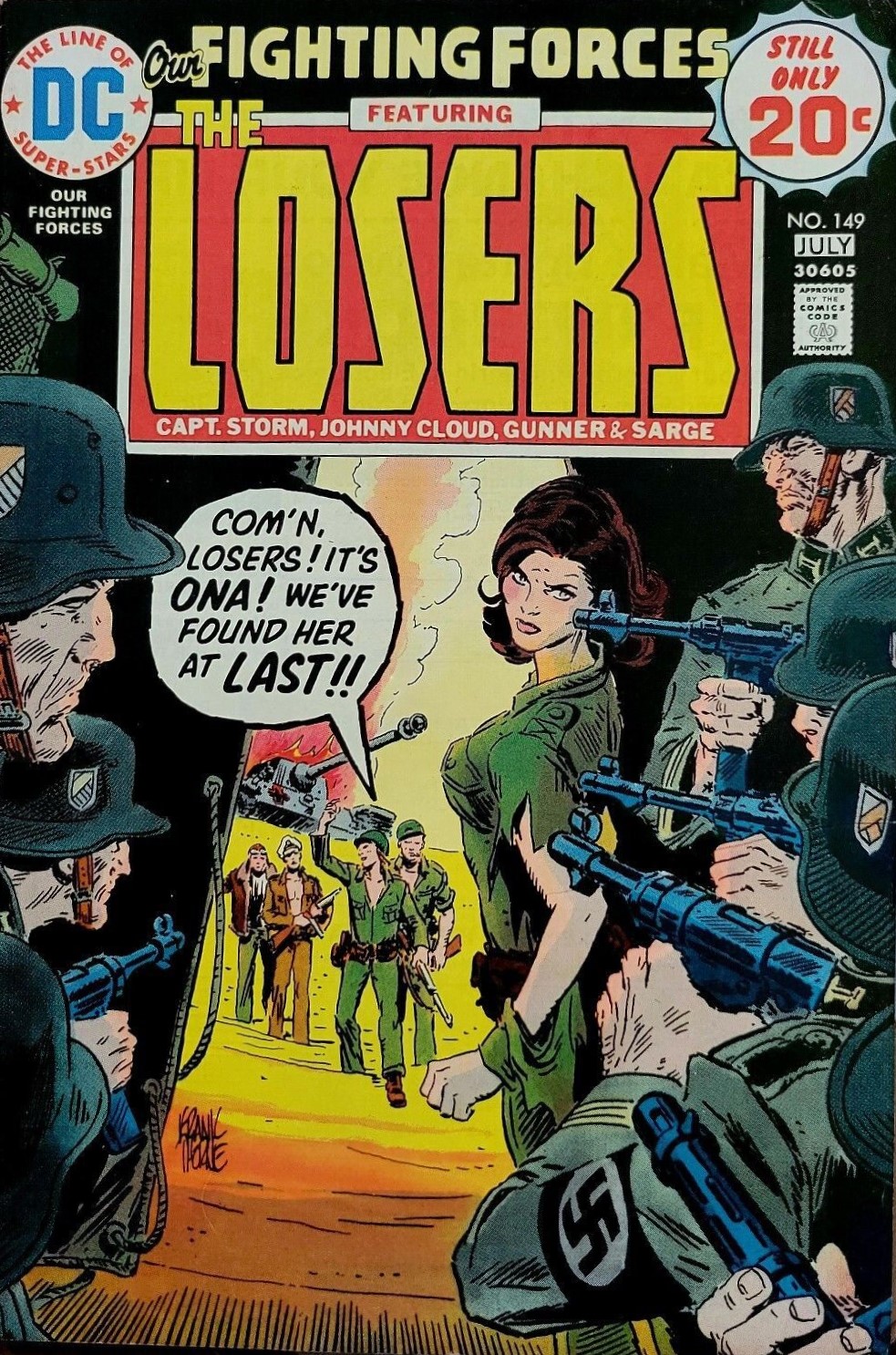
The team briefly had a female member named Ona Tomsen who was part of the Norwegian resistance movement, joining the team in issue #135.
DC wisely created this team of heroes for the sole purpose of housing former series stars. The unit served in Europe, Africa, & the Pacific, meeting other DC WWII characters such as the Haunted Tank & Sergeant Rock. Their first appearance as a group was with the Haunted Tank crew in G.I. Combat #138 (October–November 1969.) The tank crew had failed to destroy a Nazi radar station but joined by The Losers returned to the site & demolished it. By hanging on until #181 (October, 1978,) when Our Fighting Forces itself ended, making it among the longer-running war series from DC. A large number of talented creators handled The Losers over the years. Perhaps most notably, from Our Fighting Forces #151 (November, 1974) to #162 (December, 1975), when they were done by the legendary Jack Kirby.
#7 G.I. Joe, A Real American Hero – (#1 Published by Marvel Comics 31 May 1982)
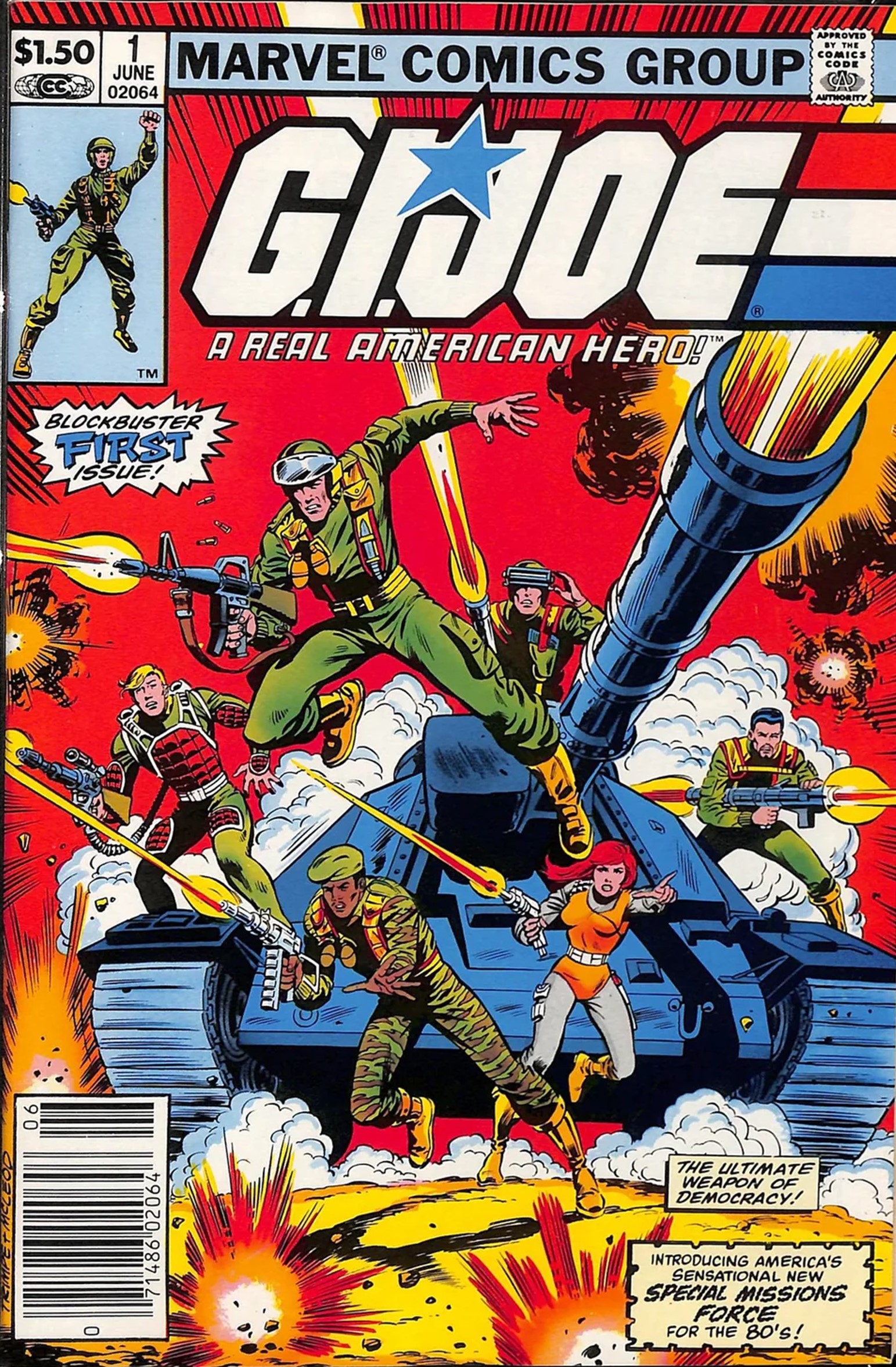
G.I. Joe, A Real American Hero is a comic book that was published by Marvel Comics published from 1982 to 1994. It was based on Hasbro's G.I. Joe line of military-themed toys that was first sold in 1964 as 12” action figures. The series has been credited for making G.I. Joe into a pop-culture phenomenon & created a historically crucial moment in media convergence as the first comic book to be advertised on television. New 3.75” action figures were created by writer, artist & editor Larry Hama, who used a realistic, character-based storytelling style for its 155-issue run. It was ahead of its time as the “Joes” had to fight Cobra Command, a worldwide evil terrorist organization that would arrive from the Middle-East less than two decades later. I was surprised with the Left’s hatred of the military that Hasbro hadn’t been forced to stop its 60-years of toy production. The new G.I. Joe is an excellent designed 6” versions of some of the most famous “Joes” & their foes from Cobra. My grandson will get his first when he turns three!
#8 Nick Fury, Agent of S.H.I.E.L.D. – (#15 / #45 Published by Marvel 1 Nov 1969 / 1 Mar 1993)

Photo: (Clockwise from top left): The original run of 15 issues ended with Nick gunned down at the very end of the Golden Age; the next run started in the Modern Era (1985 to now) with 47 issues; one of his Hydra foes was Viper (Madame Hydra;) the two Nick Fury’s on film, Marvel Films changed Nick’s race so Samuel L. Jackson could play the part bypassing the star of 1998’s TV film - David Hasselhoff.
Marvel Comics is always willing to jump on any bandwagon that might sell comic books (or movies for that matter, see their recent woke film albatrosses, “The Marvels” & “Madame Web”) countered The Man from U.N.C.L.E., Sean Connery’s James Bond from MI-6, Jame Coburn’s Our Man Flint from Z.O.W.I.E. & Dean Martin’s Matt Helm from I.C.E. with their own spy agency. Also willing to recycle old characters they dusted off now Colonel Nick Fury, putting him in charge of the unyieldingly named Strategic Homeland Intervention, Enforcement and Logistics Division (S.H.I.E.L.D.) On television, Agents of S.H.I.E.L.D. had a seven-year run 2013-20 with 136 episodes.
Famous Art
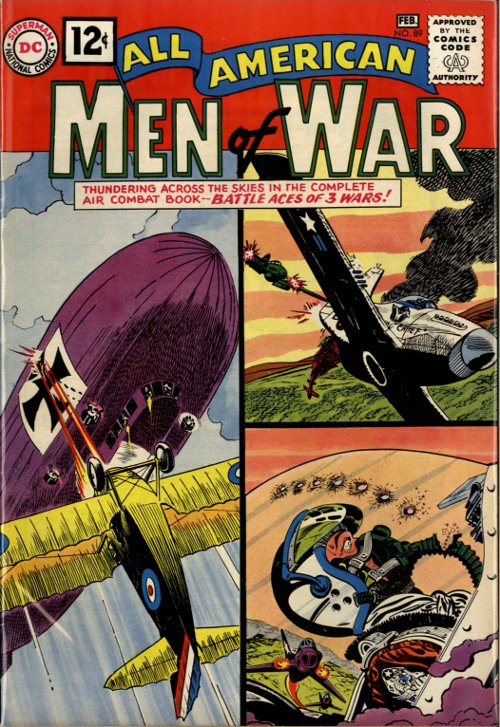
As famed in pop culture as Action #1 (June 1938 - debut of Superman) & Detective Comics #27 (10 May 1939 - debut of Batman) is All-American Men of War #89 which hit stands with a cover date of February, 1962. It is a typical issue of the series, featuring three stories, each involving the air force during a different war, WWI, WWII (Lt. Johnny Cloud, USAAF) & the Korean War. In this issue, Johnny Cloud recount a story from his childhood, when a Navaho Shaman gave him a spirit vision that revealed his future flying fighter planes. In the vision, he sees a dogfight where the Nazis appeared to him as flaming stars in the sky. Later in the story, he shoots down a German fighter & it explodes in a brilliant fireball, causing Johnny to remember this vision. The Cloud aviation story was titled "The Star Jockey."

While Andy Warhol, the king of Pop Art, was crafting his inspiration from actual mass-produced images like reimagined Campbell's Soup cans as a commentary on modern culture, Roy Lichtenstein's art was sampling & transforming images designed & executed as art from other artists. In comic books, due to the seemingly anonymity of not just the artists but the art itself, nobody raised a ruckus when images were lifted whole, appropriated, repackaged & sold as what would become one of the most important art movements of the second half of the 20th century. Lichtenstein's pieces & aesthetic have been studied for decades in art schools & hung in prestigious galleries. Only hardcore comic book fans & art historians realized that most of Lichtenstein's works were not the product of his imagination but were rather taken directly out of twelve-cent comic books.
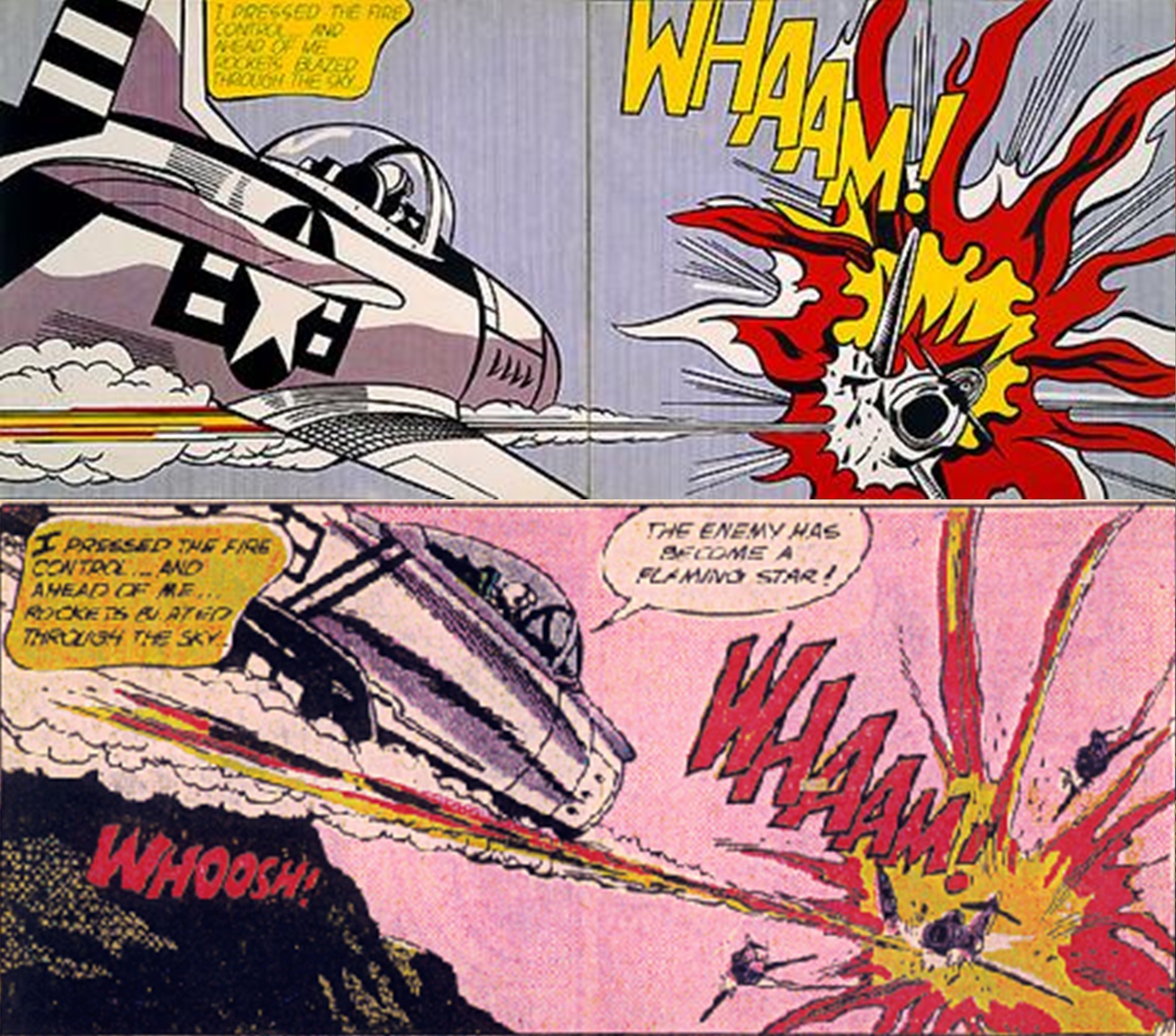
Lichtenstein took a comic panel of a WWII P-51 shooting down a propeller-driven enemy plane & blended it with a Korean era jet using a rocket to shoot down a Communist Chinese MiG 15/17 to create WHAAM! Just how much WHAAM! is worth today is hard to say, as the Tate Museum, London purchased it in 1966 for just $11,000. We can estimate that it is huge as his last three (lesser) works sold for $42.6, $43.2 & $44.8 million at Christie's New York. The original art that was used to create "WHAAM!" was done by an artist named Irv Novick who received no credit as comics didn’t list the stories contributors. However, the artists were certainly aware of Lichtenstein's appropriations for his works & was becoming wealthy & famous from art that artists like Novick were only paid a couple of hundred dollars.
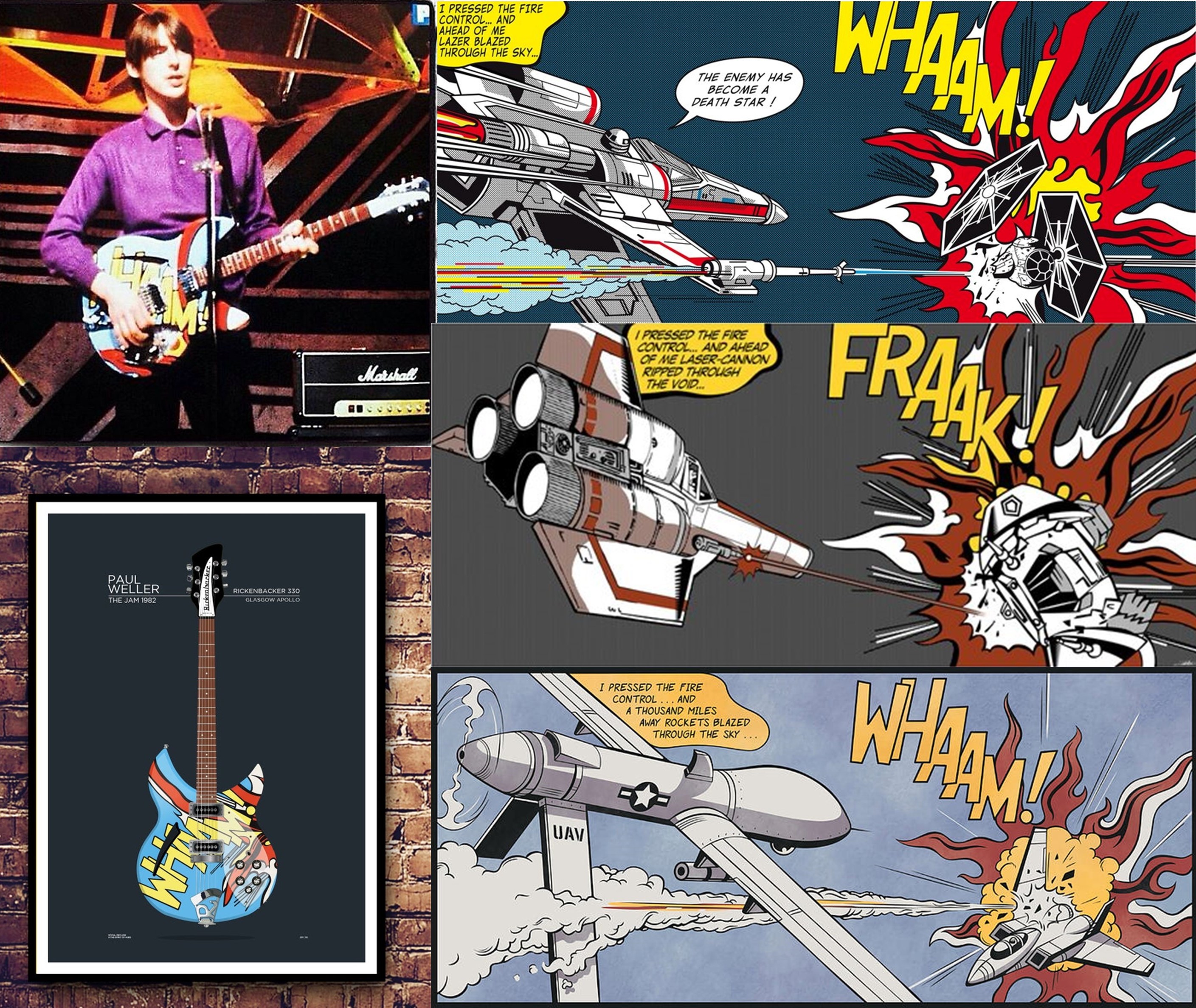
WHAAM! Is famous enough to have appeared as a custom finish on a 2014 Rickenbacker 330 played by English rockstar Paul Weller of The Jam. It has been parodied by a Star Wars X-wing starfighter defeating an Empire TIE fighter; a Battlestar Galactica Viper defeating a Cylon Raider & last a USAF Reaper Drone defeating a Mig-25 (fighter-interceptor.)
COMIC-CON
We drove up to the Gaylord National Resort & Convention Center in Maryland & noticed a 7-foot fur wearing barbarian carrying a huge rock hammer like the one that the Germanic Chief swung in Gladiator. We discovered it was a meeting of comic book enthusiast coming together to celebrate & showcase Japanese animation, science fiction/fantasy related films, television, and similar popular arts. The DC area has Katsucon, an annual 3-day fan convention held at the Gaylord National Resort & Convention Center now includes a larger range of pop culture & entertainment elements across virtually all genres, including horror, Western animation, anime, comics, manga, toys, collectible card games, video games, webcomics, & fantasy novels.
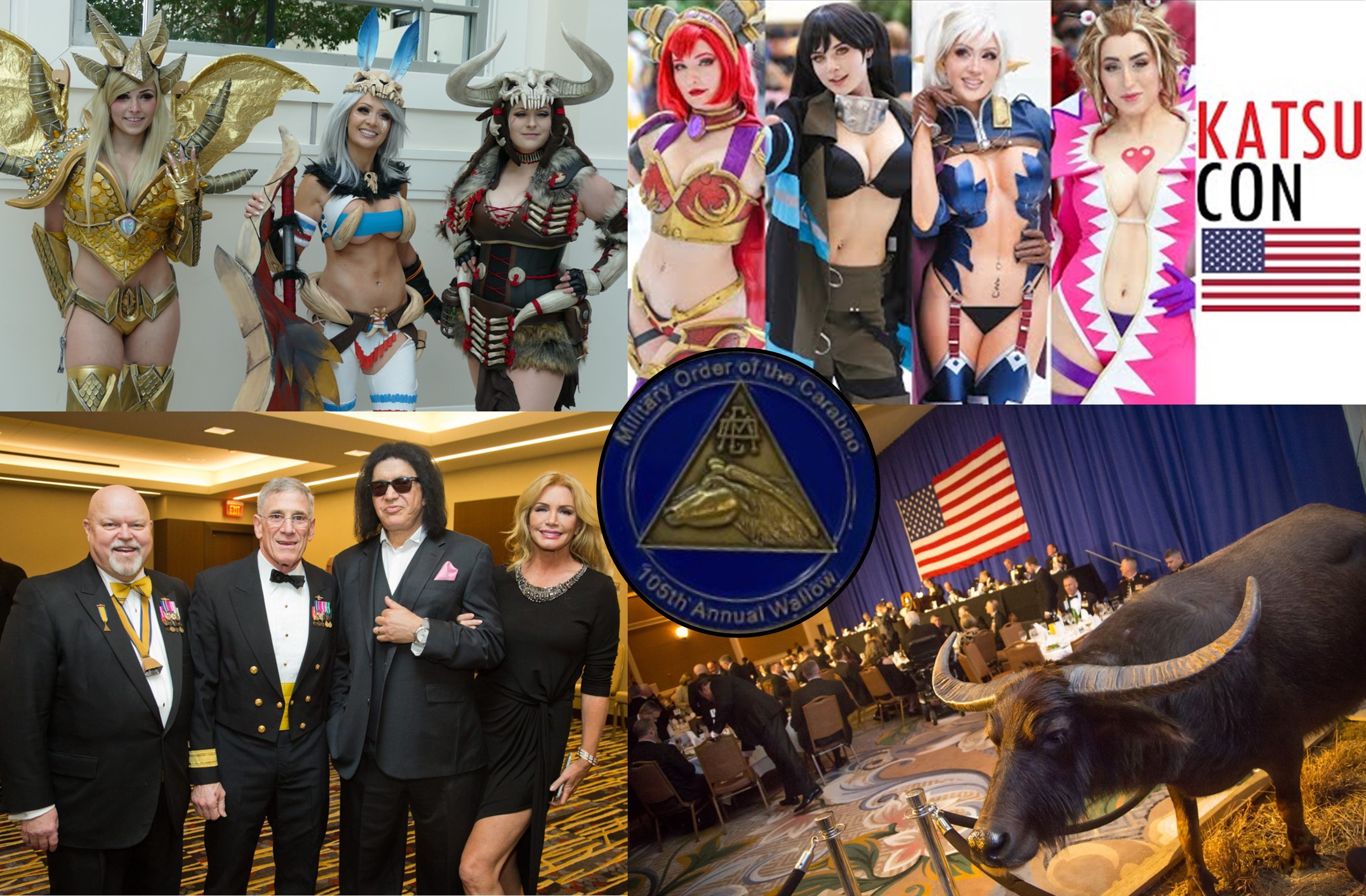
We were there for the Carabao Wallow, an organization founded in 1900 by U.S. Army officers stationed in the Philippines to lampoon the Military Order of the Dragon, founded by the soldiers who fought in the short-lived Boxer uprising in China by replacing the Chinese dragoon with the Philippines Carabao (Water Buffalo.) The organization sponsors an annual Wallow, a black-tie, military-dress affair attended by members of the U.S. military, the U.S. government, & military defense contractors. So, 2,000 Carabao attendees were mixed in with an equal number of Katsucon participants in many costumes of their favorite characters.
